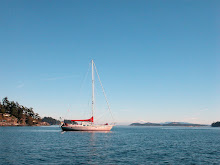Hirta Cliffs
What is striking about St Kilda is the inhospitable nature of the islands. All four of them are dominated by steep cliffs with minimal or no level ground. An environment much more suited for puffins, fulmars and gannets that nest there than humans. Only Hirta, with the highest cliffs in the British Isles and its two deep bays with no natural landing was inhabited.
Puffin Taking Off After A Dive
Apart from a small amount of gentle slopping land, it’s a rigorous vertical walk to get anywhere on the island. Even hunting sea birds, the main source of the communities food was a difficult, time consuming and dangerous task that was not always successful. The preferred method was to take a small boat to a cliff base and then climb to where the birds were nesting and capture them by hand. Though the community’s food supply was limited they always shared what they had with each other and showed extraordinary hospitality to shipwreck survivors who were victim to the archipelago’s treacherous coast.

Village Street With Houses & Cleits
The steep grass covered valley around Village Bay is covered with stone cleats that were used for storage, towering above a neat row of abandoned houses. Even the modern military base is dwarfed by the landscape.

Soay Sheep
We left St Kilda with a better understanding of its hardships and charm. The weather was ideal during our visit and were able to spend the night at anchor in Village Bay. By morning the southeasterly swell began to make the anchorage uncomfortable. After another trip to shore we pulled anchor and took Snow Dragon around to Glen Bay on the north side of Hirta to find enough protection to hoist the motor off the dinghy before setting off for the Faroe Islands. Our only souvenirs of St Kilda are our photographs as the archeologist who greeted us on shore reminded us not to remove anything from St Kilda, including Soay lambs.




No comments:
Post a Comment